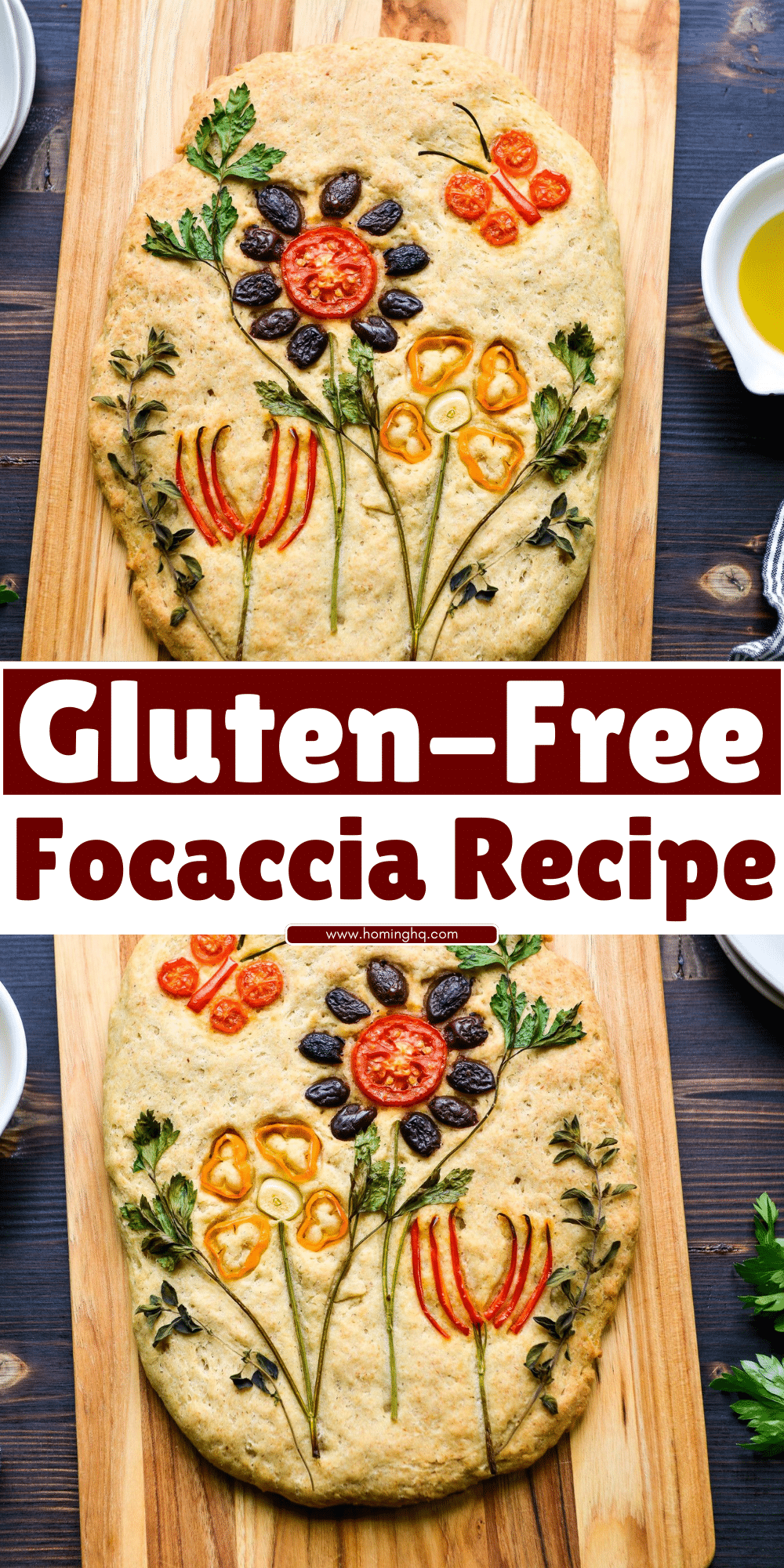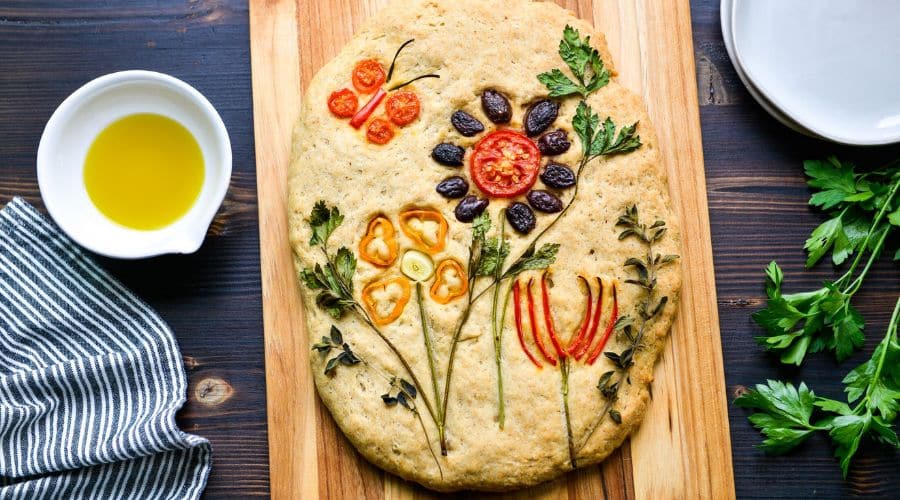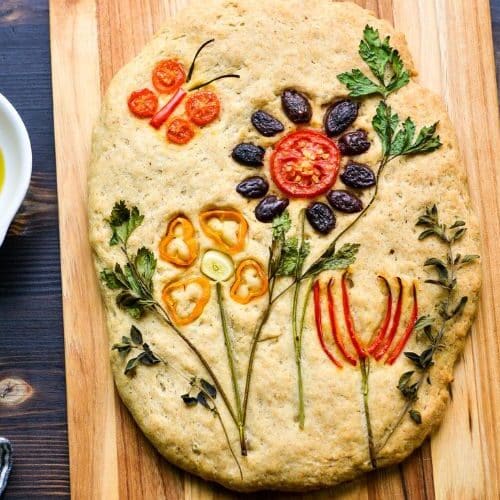All products are selected by our editorial team for quality. If you buy through our links, we may earn a small commission at no extra cost to you.
Focaccia, with its golden, crisp crust and soft, airy interior, is a beloved Italian bread that can be enjoyed in so many ways.
This Herbed Gluten-Free Focaccia recipe is the perfect option for anyone avoiding gluten but still craving the delicious, savory flavors of homemade bread.
Packed with aromatic herbs and a subtle olive oil richness, it’s just as satisfying as traditional focaccia—if not more so!
Whether you’re using it to make sandwiches, serve as a side dish, or enjoy it all on its own, this gluten-free version is sure to become a staple in your kitchen.

Why You’ll Love This Herbed Gluten-Free Focaccia
There’s a lot to love about this Herbed Gluten-Free Focaccia, starting with its texture. Unlike some gluten-free breads, this focaccia is light, fluffy, and perfectly moist.
Thanks to a mix of gluten-free flours and the right balance of ingredients, it holds up beautifully without the usual heaviness or dryness.
Additionally, the herbs—such as rosemary, thyme, and oregano—add an incredible depth of flavor.
These fragrant spices are infused into the dough and give each bite a burst of freshness.
Drizzling the dough with olive oil before baking creates that signature crispy crust, making each slice irresistible.
What’s more, it’s incredibly versatile. You can top it with your favorite ingredients like olives, garlic, or even a sprinkle of sea salt for extra flavor.
This Herbed Gluten-Free Focaccia is an easy, foolproof recipe that’s perfect for family dinners, picnics, or just satisfying your bread cravings without gluten.
What You Need to Make Herbed Gluten-Free Focaccia
To make this Herbed Gluten-Free Focaccia, you’ll need the following ingredients:
Flours and Starches
- Gluten-Free All-Purpose Flour: This is the base of the dough and provides structure. Be sure to choose a good-quality, all-purpose gluten-free flour blend for the best texture.
- Tapioca Flour: Helps with the elasticity of the dough, giving it that soft, chewy interior.
- Brown Rice Flour: Adds a mild flavor and works well alongside other flours for balance.
Herbs and Flavorings
- Fresh Rosemary and Thyme: These classic herbs give the focaccia its signature flavor. You can also experiment with other herbs, such as oregano or sage, if you prefer.
- Garlic Powder: A subtle but important addition that enhances the savory notes.
- Sea Salt: For seasoning both the dough and for sprinkling on top before baking.
Wet Ingredients
- Warm Water: Helps activate the yeast and create the right texture in the dough.
- Active Dry Yeast: This is essential for helping the bread rise and become light and fluffy.
- Olive Oil: A generous amount is used both in the dough and to coat the surface before baking for that golden, crispy crust.
- Honey or Sugar: A small amount to help feed the yeast and give a touch of sweetness to balance the savory flavors.
With these ingredients, you’ll be able to create a flavorful and fragrant gluten-free focaccia that’s sure to impress.
Step-by-Step Instructions for Perfect Herbed Gluten-Free Focaccia

Creating the perfect Herbed Gluten-Free Focaccia may seem intimidating, but it’s actually a simple and straightforward process. Follow these easy steps to achieve a beautifully light and flavorful focaccia.
Step 1: Activate the Yeast
Start by combining warm water (about 110°F) with honey (or sugar) in a small bowl. Sprinkle the active dry yeast over the surface and stir gently.
Let the mixture sit for about 5-10 minutes until it becomes frothy.
This indicates that the yeast is active and ready to help the dough rise.
Step 2: Mix the Dry Ingredients
In a large mixing bowl, combine the gluten-free all-purpose flour, tapioca flour, brown rice flour, garlic powder, and a pinch of sea salt.
Stir the dry ingredients until they are evenly distributed.
Step 3: Combine Wet and Dry Ingredients
Once the yeast mixture is frothy, pour it into the bowl with the dry ingredients.
Add in 2 tablespoons of olive oil. Stir everything together using a spoon or a stand mixer fitted with a dough hook, until the dough comes together.
It should be a sticky, shaggy dough—this is perfectly normal for gluten-free bread.
Step 4: Knead the Dough
Knead the dough in the bowl for about 3-5 minutes. Gluten-free dough doesn’t need as much kneading as traditional dough, but this step helps develop some structure.
If you’re using a stand mixer, let it go for about 3 minutes on low speed.
The dough should be soft, slightly sticky, and easy to handle.
Step 5: First Rise
Cover the bowl with a clean kitchen towel or plastic wrap and place it in a warm, draft-free area to rise for about 45 minutes to 1 hour. The dough should nearly double in size during this time.
Step 6: Shape the Focaccia
Preheat your oven to 400°F (200°C). Once the dough has risen, lightly oil a baking sheet or a square baking pan.
Transfer the dough onto the pan and gently spread it out with your hands, shaping it into an even rectangle or square.
Don’t worry about getting it perfect; a rustic look adds to the charm!
Step 7: Add Herbs and Olive Oil
Before baking, drizzle the dough with the remaining olive oil.
Use your fingertips to gently press small indentations into the dough, creating those signature focaccia dimples.
Sprinkle fresh rosemary, thyme, and a bit of sea salt evenly over the top.
You can also add a few extra herbs or toppings, such as sliced olives, if you wish.
Step 8: Bake the Focaccia
Place the focaccia in the preheated oven and bake for 20-25 minutes, or until the crust is golden brown and the bread sounds hollow when tapped on the bottom.
The top should be slightly crispy, and the inside should be soft and fluffy.
Step 9: Cool and Serve
Once baked, remove the focaccia from the oven and let it cool slightly on a wire rack.
Slice and serve warm, or store it in an airtight container for up to 2 days.
Enjoy it as a side dish, with a spread, or as a delicious base for sandwiches!
Tips for Achieving the Best Texture and Flavor
Achieving the perfect texture and flavor in gluten-free focaccia can be tricky, but with a few simple tips, you can ensure your bread turns out perfectly every time.
1. Use a High-Quality Gluten-Free Flour Blend
The quality of your gluten-free flour blend is crucial for a light and airy texture.
Look for a flour blend that contains a mix of flours and starches, which will help mimic the texture of traditional wheat flour.
Avoid flour blends with too many heavy ingredients, as they can result in dense bread.
2. Let the Dough Rise Fully
While gluten-free dough doesn’t rise as much as traditional dough, allowing it to rise properly is still essential.
Make sure to give the dough enough time to double in size during the first rise.
This will help develop the structure and airiness that makes focaccia so delightful.
3. Olive Oil Is Your Friend
Don’t skimp on the olive oil—it adds flavor, moisture, and helps create the crisp, golden crust that focaccia is known for.
Drizzling olive oil over the dough before baking is key to achieving that perfect finish.
4. Experiment with Herbs and Toppings
While rosemary and thyme are traditional, feel free to get creative with your herbs and toppings.
Add a sprinkle of oregano, a few slices of garlic, or even olives or sun-dried tomatoes for an extra burst of flavor.
5. Don’t Overmix the Dough
Gluten-free dough is more delicate than wheat-based dough. When mixing the ingredients, avoid overworking the dough.
Stir just enough to incorporate everything together, and remember that a slightly sticky dough is normal for gluten-free recipes.
By following these tips, you’ll be able to achieve a focaccia that’s both flavorful and perfectly textured—crispy on the outside, soft and airy on the inside.
How to Store and Reheat Your Focaccia
To keep your Herbed Gluten-Free Focaccia fresh and delicious, it’s important to store it properly.
Storing Your Focaccia
Once your focaccia has cooled, store it in an airtight container at room temperature for up to 2 days.
It’s best enjoyed fresh, but if you want to keep it longer, you can freeze it.
Freezing Focaccia
To freeze, wrap the focaccia tightly in plastic wrap or foil, then place it in a freezer-safe bag or container.
It will keep for up to 1 month. When you’re ready to enjoy it again, simply thaw it at room temperature.
Reheating Focaccia
To reheat focaccia, place slices on a baking sheet and warm it in a preheated oven at 350°F (175°C) for about 10-15 minutes.
This will help restore its crispy crust while keeping the inside soft.
Alternatively, you can reheat individual slices in a toaster or on a skillet for a quicker option.
Final Thoughts
This Herbed Gluten-Free Focaccia recipe is a perfect solution for anyone who’s missing the taste and texture of traditional focaccia while following a gluten-free lifestyle.
Its fluffy, aromatic interior and golden, crispy exterior make it an instant crowd-pleaser.
Whether you’re serving it at a family dinner, pairing it with a bowl of soup, or using it to create delicious sandwiches, this gluten-free focaccia is sure to impress.
With a few simple ingredients and easy-to-follow steps, you can enjoy the comforting flavors of freshly baked focaccia in no time.
So, grab your mixing bowl, preheat the oven, and get ready to enjoy a homemade gluten-free treat that everyone will love.
Frequently Asked Questions
1. Can I use other gluten-free flour blends?
Yes, you can experiment with other gluten-free flour blends, but make sure they include a combination of flours and starches for the best texture.
Avoid using just one flour type (like rice flour or almond flour) as this may affect the texture and rise of the focaccia.
2. How can I make the focaccia more flavorful?
To add more flavor, try incorporating additional toppings like olives, garlic, or sun-dried tomatoes.
You can also mix extra herbs like basil, sage, or oregano into the dough or on top before baking.
3. Can I make this recipe vegan?
Yes! This recipe is already dairy-free if you use a plant-based alternative to honey, such as maple syrup or agave.
Just make sure to use a dairy-free butter substitute if you plan to add butter to the dough or topping.
4. How can I adjust the texture if my dough is too sticky?
If your dough is too sticky to handle, you can add a little more gluten-free flour, one tablespoon at a time, until it becomes more manageable.
Just be careful not to add too much flour, as it could affect the final texture.
5. Can I make this focaccia ahead of time?
Yes, you can make the focaccia ahead of time and store it at room temperature for up to 2 days.
You can also bake it the night before and reheat it before serving for a warm, freshly-baked taste.

Herbed Gluten-Free Focaccia
Equipment
- 1 large mixing bowl
- 1 Small bowl (for yeast activation)
- 1 baking sheet or square baking pan
- 1 Clean kitchen towel or plastic wrap (for covering dough)
- Measuring spoons and cups
- Stand mixer (optional, with dough hook attachment)
- Baking sheet or square pan (9×9 or similar size)
Ingredients
- 1 ½ cups 180g Gluten-Free All-Purpose Flour
- ½ cup 60g Tapioca Flour
- ½ cup 60g Brown Rice Flour
- 1 tsp 5g Garlic Powder
- 2 tsp 10g Active Dry Yeast
- 1 tsp 5g Honey (or sugar)
- 1 ½ cups 360ml Warm Water
- 4 tbsp 60ml Olive Oil (divided)
- 1 ½ tsp 7g Sea Salt
- 2 tsp 2g Fresh Rosemary (chopped)
- 2 tsp 2g Fresh Thyme (chopped)
Instructions
- Activate the Yeast: In a small bowl, combine warm water with honey (or sugar) and sprinkle in the yeast. Stir to combine, then let sit for 5-10 minutes until frothy.
- Mix Dry Ingredients: In a large mixing bowl, combine the gluten-free all-purpose flour, tapioca flour, brown rice flour, garlic powder, and sea salt. Stir to evenly distribute the dry ingredients.
- Combine Wet and Dry Ingredients: Pour the activated yeast mixture into the dry ingredients and add 2 tablespoons of olive oil. Stir with a spoon or use a stand mixer to combine everything into a sticky dough.
- Knead the Dough: Knead the dough for about 3-5 minutes by hand or using a stand mixer with a dough hook. The dough should be slightly sticky but soft.
- First Rise: Cover the dough with a clean kitchen towel or plastic wrap. Place it in a warm area for about 45 minutes to 1 hour until it has nearly doubled in size.
- Preheat Oven and Prepare Pan: Preheat your oven to 400°F (200°C). Grease a baking sheet or square baking pan with the remaining olive oil.
- Shape the Focaccia: Gently transfer the risen dough to the prepared pan and press it out into an even layer using your hands. Create dimples in the dough with your fingers.
- Add Toppings: Drizzle the remaining olive oil over the top of the dough. Sprinkle the chopped rosemary, thyme, and sea salt over the surface.
- Bake: Place the focaccia in the oven and bake for 20-25 minutes, or until the top is golden brown and the bread sounds hollow when tapped on the bottom.
- Cool and Serve: Remove the focaccia from the oven and let it cool slightly. Slice and serve warm. Enjoy!
Notes
- Flour Blend: You can experiment with different gluten-free flour blends, but make sure they are suitable for baking. A good blend with xanthan gum or guar gum will give the best results.
- Herbs: Fresh herbs like rosemary and thyme give this focaccia its signature flavor, but you can try other herbs like sage, oregano, or basil.
- Storage: Store leftover focaccia in an airtight container at room temperature for up to 2 days, or freeze for up to a month. Reheat by warming in the oven or toaster.
- Topping Variations: Feel free to add olives, sun-dried tomatoes, or garlic slices to customize your focaccia.
- Dough Texture: Gluten-free dough tends to be stickier than traditional bread dough, so don’t worry if it feels a little different—this is normal!

